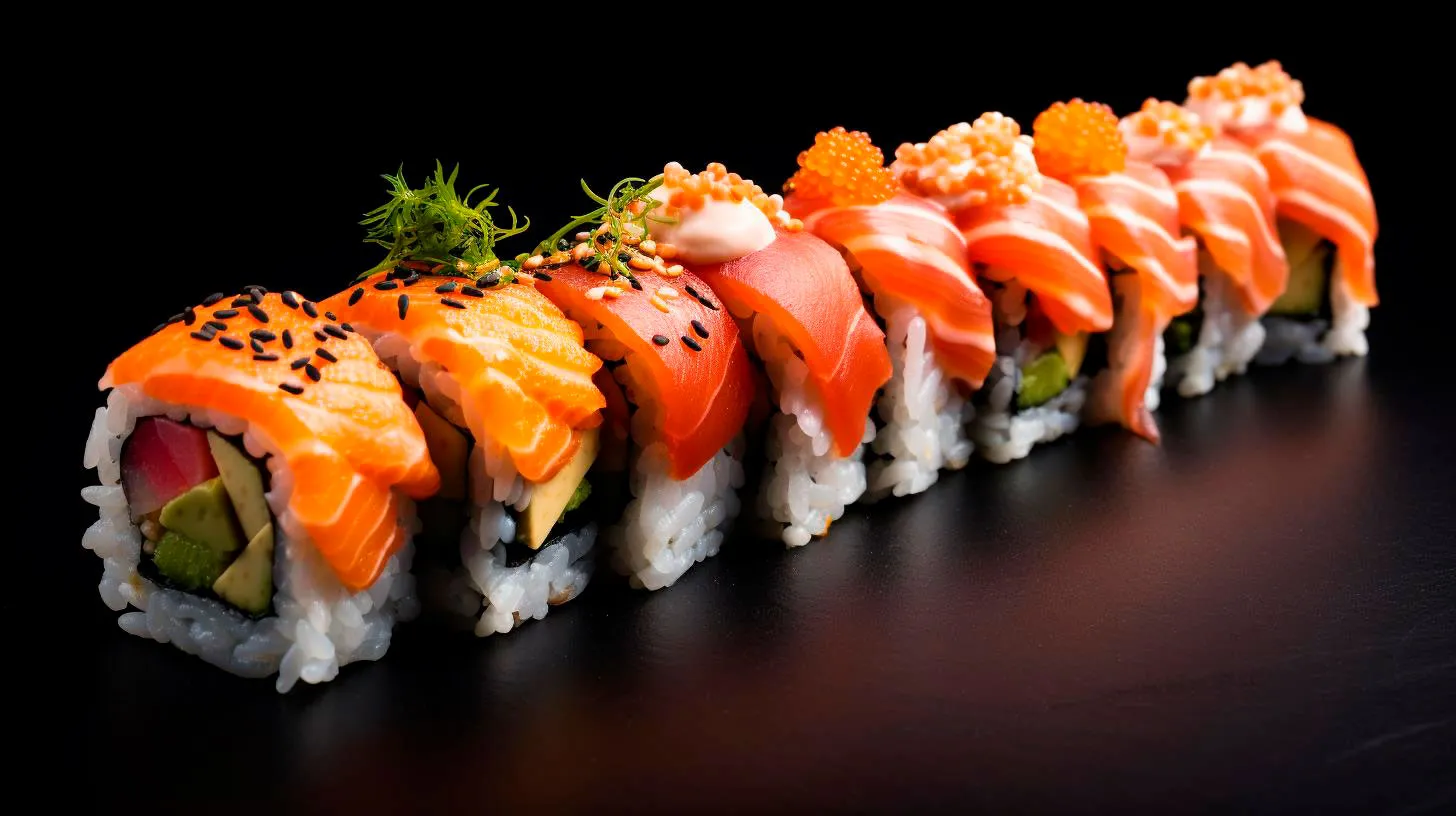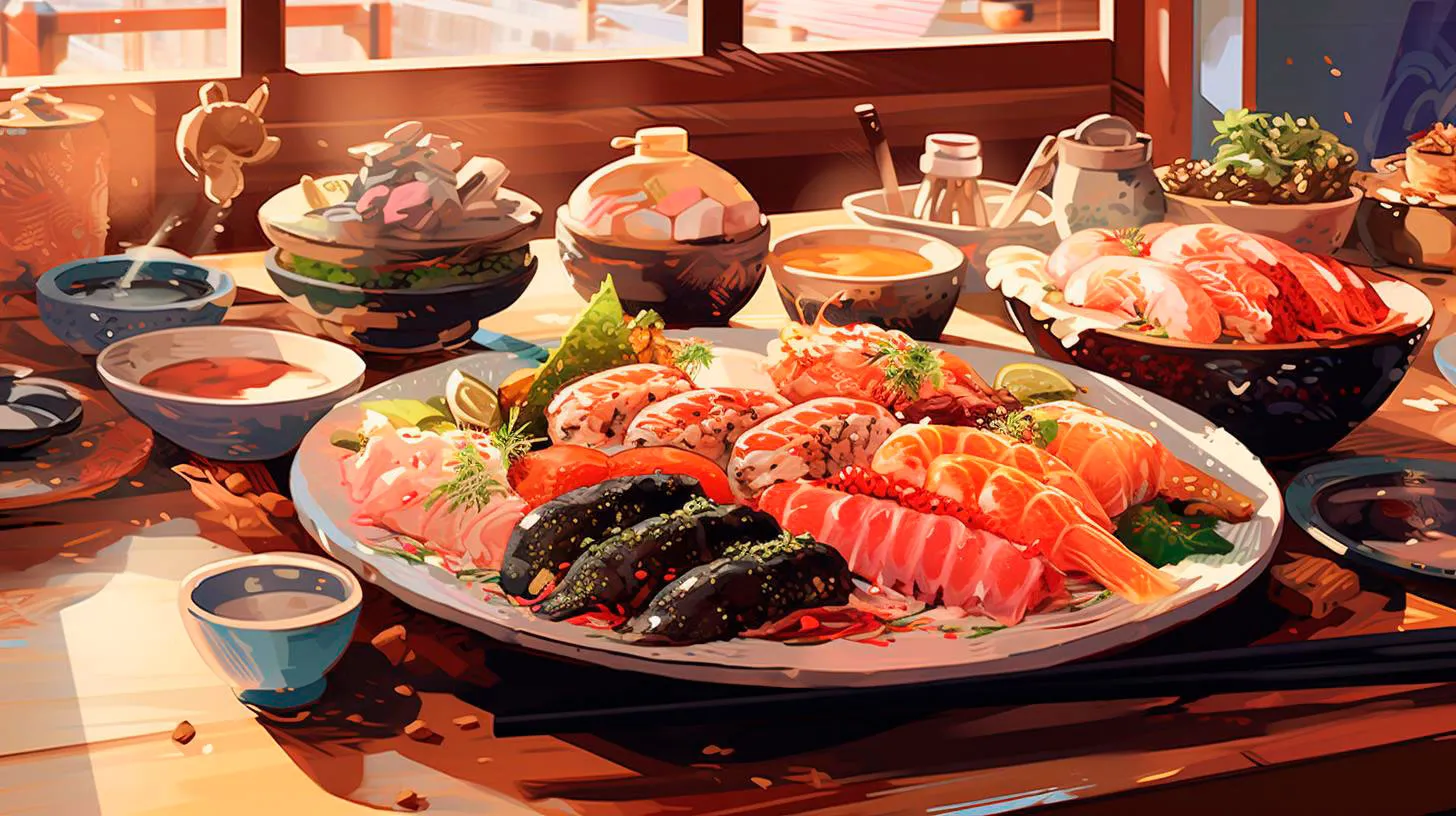The Intricacies of Crafting Perfect Sushi
In this article, we will delve into the intricacies of crafting perfect sushi and understand the techniques and ingredients involved in making this artful culinary creation.
The Art of Sushi Making
Sushi making is a revered form of culinary art that originated in Japan. It involves combining cooked rice with various ingredients such as fresh fish, vegetables, and seaweed. What sets sushi apart is the meticulousness required in its preparation. Let’s explore the essential elements that contribute to perfect sushi:
- Flavorful Rice: The foundation of any good sushi lies in the quality of the rice used. Sushi rice should be short-grain and sticky, seasoned with a perfect balance of rice vinegar, sugar, and salt.
- Fresh and High-Quality Ingredients: To create sushi that truly stands out, it is crucial to use only the freshest ingredients. Whether it’s the fish, vegetables, or condiments, every element should be of exceptional quality.
- Knife Skills: Sushi chefs possess exemplary knife skills, enabling them to slice the ingredients with precision. Thin, uniform slices of fish or vegetables not only enhance the visual appeal but also ensure a harmonious texture.
- Attention to Detail: Every roll and nigiri must be crafted with great care. The art of sushi making lies in the intricate details, such as ensuring the rice is evenly spread, the ingredients are well-proportioned, and the rolls are tightly wrapped.
The Key Types of Sushi
Sushi comes in various forms, each offering a unique experience. Here are some of the key types of sushi you should try:
1. Nigiri Sushi:
Nigiri sushi consists of a small mound of sushi rice topped with a slice of fresh fish or seafood. This type of sushi allows you to appreciate the natural flavors of the fish and is often enjoyed with a touch of soy sauce and wasabi.
2. Maki Sushi:
Maki sushi is perhaps the most recognized form of sushi. It involves rolling sushi rice, fish, and vegetables tightly with seaweed sheets (nori) using a bamboo mat. Maki sushi is sliced into bite-sized pieces and offers a delightful blend of flavors and textures.
3. Sashimi:
Sashimi is a sushi style where only thinly sliced, raw fish or seafood is served without rice. It allows you to experience the pure flavors and delicate texture of the fish, coupled with a refreshing dip in soy sauce and wasabi.
The Advantages of Perfectly Crafted Sushi
Enjoying perfectly crafted sushi offers numerous advantages, from taste and nutrition to cultural exploration. Here are some key advantages of indulging in this culinary delight:
- Health Benefits: Sushi often incorporates nutrient-rich ingredients like fish, seaweed, and vegetables. These ingredients provide essential vitamins, minerals, and Omega-3 fatty acids, contributing to a healthy diet.
- Delicious and Refreshing: The combination of flavors and textures in sushi makes it a delightful treat for your palate. The blend of umami from fish, sweetness from rice, and the subtle tang of wasabi create a unique and refreshing taste.
- Presentation: A perfectly crafted sushi platter is a feast for the eyes. The vibrant colors, artful arrangement, and meticulous presentation of each piece showcase the attention to detail and elevate the dining experience.
- Cultural Experience: Trying sushi allows you to immerse yourself in Japanese culture. The traditional techniques, rituals, and ingredients offer a glimpse into a rich culinary heritage that has been perfected over centuries.
The Fascinating Statistics on Sushi Consumption
Sushi has witnessed a global surge in popularity over the years. Here are some fascinating statistics on sushi consumption:
- More than 45 billion portions of sushi are consumed annually around the world.
- The United States alone sells approximately $3.5 billion worth of sushi each year.
- In Japan, the birthplace of sushi, the annual sushi market is valued at over $14 billion.
- California roll is considered one of the most popular sushi rolls in the United States.
- In Japan, it is estimated that there are over 9,000 sushi restaurants, ranging from high-end establishments to small local joints.
Sushi has indeed transcended borders and become a global culinary phenomenon, attracting sushi enthusiasts from all walks of life.
Key Takeaways
Crafting perfect sushi is an intricate process that requires attention to detail, fresh ingredients, and an understanding of traditional Japanese techniques. Here are the key takeaways from this article:
- Sushi making is an art form that demands precision and skill.
- Flavorful rice, fresh ingredients, knife skills, and attention to detail are vital for perfect sushi.
- Nigiri sushi, maki sushi, and sashimi are some of the key types of sushi to explore.
- Perfectly crafted sushi offers health benefits, delightful taste, cultural experience, and visual appeal.
- Sushi consumption is on the rise globally, with impressive statistics showcasing its popularity.
So the next time you savor a carefully crafted piece of sushi, take a moment to appreciate the culinary artistry behind it and the intricacies that make it a truly unforgettable dining experience.
Unleashing Creativity through Nature Inspiration
In this article, we explore how immersing ourselves in nature can fuel our creativity and provide us with a fresh perspective on life.
Connecting with the Natural World
In today’s fast-paced digital world, it’s easy to feel disconnected from nature. Yet, research has revealed that spending time in nature has numerous benefits for our mental health and overall well-being. Beyond these advantages, nature also holds vast potential to awaken our creativity.
When we embrace the beauty of nature, we give ourselves the opportunity to observe the intricate patterns, colors, and textures that exist around us. By taking a moment to appreciate nature’s wonders, we can begin to notice the small details that often go unnoticed in our everyday lives. This heightened sense of observation can serve as a powerful tool for creative inspiration.
The Role of Nature in Inspiration
Nature has long been a source of inspiration for many creative minds. From painters capturing the beauty of landscapes to poets finding solace in the tranquility of forests, nature has the ability to evoke emotions and ignite the creativity within us. By immersing ourselves in natural environments, we can tap into the following benefits:
- Relaxation: Nature’s calming presence can help reduce stress and anxiety, providing a fertile ground for creativity to flourish.
- Stimulates the Senses: The sights, sounds, and scents of nature engage our senses, stimulating our imagination and opening up new avenues of creative expression.
- Unleashes Curiosity: Nature’s intricate ecosystems and diverse species fuel our curiosity, prompting us to explore and discover new ideas.
A Fresh Perspective
One of the key benefits of drawing inspiration from nature is its ability to shift our perspective. Spending time in nature can help us break free from our routines and immerse ourselves in a world far removed from our own. This change in scenery can spark new ideas and enable us to see things from a different angle.
Studies have shown that exposure to natural environments can enhance our cognitive abilities, such as problem-solving and creative thinking. Nature’s vastness and complexity encourage us to think outside the box and explore unconventional solutions. By stepping outside our comfort zones and embracing the natural world, we can unleash our creativity and develop a fresh perspective on life’s challenges.
Tips for Embracing Nature-Inspired Creativity
Here are a few practical ways to tap into nature’s creative potential:
- Connect with your surroundings: Take regular walks in nature, observe your surroundings, and let the beauty and serenity inspire you.
- Document your experiences: Keep a nature journal or a sketchbook to capture your observations, thoughts, and ideas.
- Experiment with different elements: Use natural materials like leaves, flowers, or shells in your artistic endeavors to infuse your creations with the essence of nature.
- Find inspiration in biodiversity: Explore the diverse flora and fauna around you to find inspiration in their shapes, colors, and interactions.
- Attend nature workshops: Participate in art or photography workshops that focus on capturing nature’s beauty, as these can provide great opportunities for learning and inspiration.
Unlock Your Creative Potential
Nature has an incredible power to unleash our creativity and inspire us in ways that the digital world cannot. By reconnecting with nature, we can tap into its boundless beauty and wisdom while discovering our own unique creative potential.
So, the next time you’re feeling stuck or in need of a fresh perspective, step outside, immerse yourself in nature, and let its awe-inspiring wonders ignite your creativity. It might just be the key to unlocking your true creative potential.
Remember, creativity is not limited to a select few; it resides within all of us. By embracing nature’s inspiration, we can unleash our creative spirit and embark on a fulfilling journey of self-expression.
Exploring the Boundless Influence of Nature
In this article, we will delve deeper into the boundless influence of nature and explore its impact on various domains.
The Impact on Urban Planning
Urban planning is an area where nature’s influence is most evident. The design of cities has significantly evolved over the years to incorporate nature-inspired elements that enhance the quality of life for residents.
- Green Spaces: The integration of parks, gardens, and other green spaces within cities has numerous benefits. Not only do these areas provide space for recreation and relaxation, but they also contribute to improving air quality and reducing urban heat islands.
- Biophilic Design: Inspired by nature, biophilic design principles are increasingly being adopted in urban planning. Incorporating natural elements such as sunlight, plants, and water into buildings has been proven to enhance well-being and productivity.
- Sustainable Development: Nature’s influence has also steered urban planning towards sustainable development. Emphasizing the conservation of natural resources, cities are now implementing renewable energy systems, efficient waste management, and sustainable transportation networks.
Technology and Nature
Contrary to popular belief, the development of technology is deeply intertwined with nature. Nature has served as a constant source of inspiration for innovators and has helped shape the evolution of technology in remarkable ways.
- Bio-inspired Engineering: Researchers have looked to nature to solve complex engineering problems. For example, by studying the aerodynamics of bird flight, scientists have developed more efficient wind turbine designs.
- AI and Natural Systems: Artificial intelligence is increasingly incorporating natural systems into its algorithms. Machine learning algorithms inspired by neural networks mimic the brain’s structure, allowing for faster and more accurate data processing.
- Renewable Energy: The push for renewable energy sources stems from the desire to reduce our dependence on fossil fuels and protect the environment. Solar panels and wind turbines are prime examples of technology inspired by nature’s ability to harness energy efficiently.
Nature-inspired Materials
Materials science is another realm where nature’s influence is hard to ignore. From architecture to fashion, nature has provided us with a rich source of inspiration for developing innovative and sustainable materials.
- Biomimicry: By observing nature, scientists have developed technologies that mimic the unique properties of natural materials. This has led to the creation of stronger and lighter materials, such as bio-inspired adhesives and self-cleaning surfaces.
- Eco-friendly Textiles: The fashion industry, notorious for its environmental footprint, is turning to nature-inspired materials. Fibers made from bamboo, hemp, and recycled materials are gaining popularity due to their sustainable production processes and reduced ecological impact.
- Nanotechnology: Nature’s intricate structures inspire advancements in nanotechnology. For instance, studying the lotus leaf’s water-repellent properties has led to the development of self-cleaning coatings and stain-resistant fabrics.
The Key Takeaway
Nature’s boundless influence on our world cannot be understated. From urban planning to technology and materials science, its impact is profound and wide-ranging. Recognizing and harnessing nature’s influence allows us to create more sustainable and harmonious solutions for a better future.
Understanding the significance of nature’s influence opens up endless possibilities for innovation and problem-solving. Embracing nature-inspired solutions can help us build more resilient cities, develop cutting-edge technologies, and create sustainable materials. By integrating nature into our designs and systems, we can lead the way towards a greener and more interconnected world.
So, let us not overlook the boundless influence of nature but instead embrace it and strive to learn from its wisdom.



